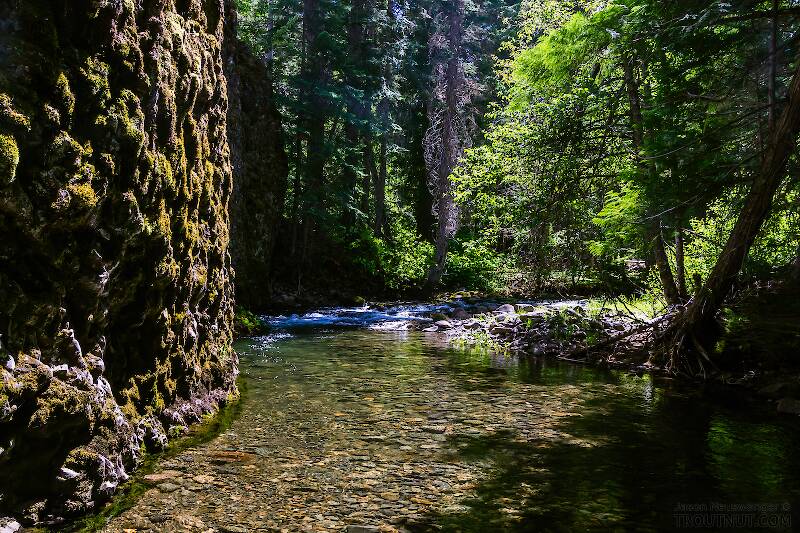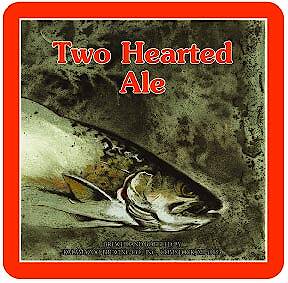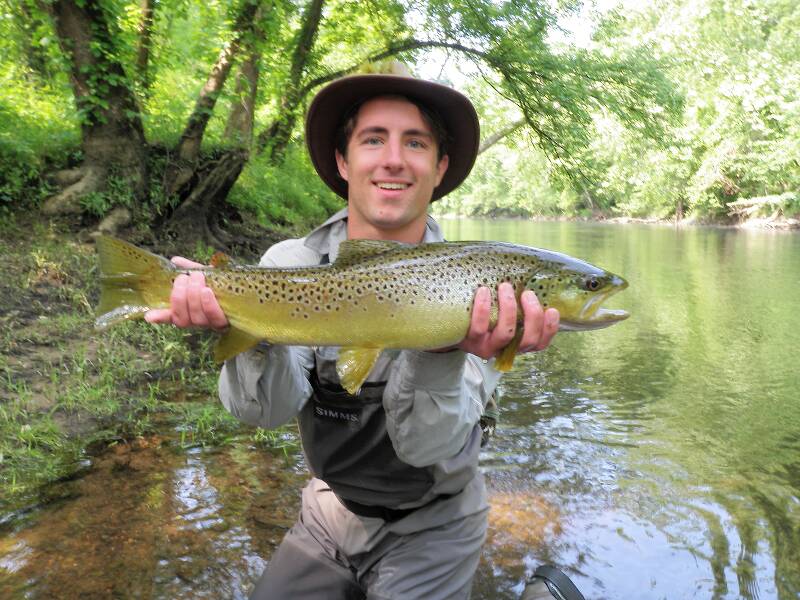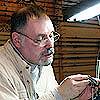
Salmonflies
Pteronarcys californica
The giant Salmonflies of the Western mountains are legendary for their proclivity to elicit consistent dry-fly action and ferocious strikes.
Featured on the forum

This is a striking caddis larva with an interesting color pattern on the head. Here are some characteristics I was able to see under the microscope, but could not easily expose for a picture:
- The prosternal horn is present.
- The mandible is clearly toothed, not formed into a uniform scraper blade.
- The seems to be only 2 major setae on the ventral edge of the hind femur.
- Chloride epithelia seem to be absent from the dorsal side of any abdominal segments.
Based on these characteristics and the ones more easily visible from the pictures, this seems to be Grammotaulius. The key's description of the case is spot-on: "Case cylindrical, made of longitudinally arranged sedge or similar leaves," as is the description of the markings on the head, "Dorsum of head light brownish yellow with numerous discrete, small, dark spots." The spot pattern on the head is a very good match to figure 19.312 of Merritt R.W., Cummins, K.W., and Berg, M.B. (2019). The species ID is based on Grammotaulius betteni being the only species of this genus known in Washington state.
- The prosternal horn is present.
- The mandible is clearly toothed, not formed into a uniform scraper blade.
- The seems to be only 2 major setae on the ventral edge of the hind femur.
- Chloride epithelia seem to be absent from the dorsal side of any abdominal segments.
Based on these characteristics and the ones more easily visible from the pictures, this seems to be Grammotaulius. The key's description of the case is spot-on: "Case cylindrical, made of longitudinally arranged sedge or similar leaves," as is the description of the markings on the head, "Dorsum of head light brownish yellow with numerous discrete, small, dark spots." The spot pattern on the head is a very good match to figure 19.312 of Merritt R.W., Cummins, K.W., and Berg, M.B. (2019). The species ID is based on Grammotaulius betteni being the only species of this genus known in Washington state.

Troutnut is a project started in 2003 by salmonid ecologist Jason "Troutnut" Neuswanger to help anglers and
fly tyers unabashedly embrace the entomological side of the sport. Learn more about Troutnut or
support the project for an enhanced experience here.
Keystoner on Oct 25, 2011October 25th, 2011, 7:47 pm EDT
I have a few questions about sink tips. Until recently, I had been under the impression that a sink tip was a designation for a fly line, as in a floating line with a tip that sinks, one piece. However, since moving out west I am seeing sink tips that can be ADDED to a conventional flyline via locking loops. I had also thought that sink tips where exclusive to the spey casting set, however, recently I have seen them prescribed for a variety of applications, mostly nymphing related, using single handed rods.
What is the deal here?? When I go to the fly shop I see a dizzying array of stuff. Different grain counts, lengths, etc. Buzzwords everywhere, "Skagit", "Scandi", and the like. I've evern heard of people making their own.
Would someone be willing to educate me here?? For starters, if I have a 6wt rod, what is the best sink tip to ad. Length? Grains? I'm looking for versatile and user friendly here. Thanks.
What is the deal here?? When I go to the fly shop I see a dizzying array of stuff. Different grain counts, lengths, etc. Buzzwords everywhere, "Skagit", "Scandi", and the like. I've evern heard of people making their own.
Would someone be willing to educate me here?? For starters, if I have a 6wt rod, what is the best sink tip to ad. Length? Grains? I'm looking for versatile and user friendly here. Thanks.
"Out into the cool of the evening, strolls the Pretender. He knows that all his hopes and dreams, begin and end there." -JB
Entoman on Oct 25, 2011October 25th, 2011, 8:24 pm EDT
Hi Matt,
Wow, An article could be written on this topic (lots have been over the years). Splicing lines, loops and such are a West Coast steelhead tradition since the days of Myron Gregory and the halcyon years of the Golden Gate Casting Club. I did my experimenting with them as well back in the day when all you could buy was nylon floating, dacron sinking, and lead core lines to splice, loop, and combine. Those lead cores were a dream to work with.:)
My advice is to stick with one piece for general use trout fishing as the connector going back and forth through the guides is a bit problematic. I like the Teeny lines and recommend the T-130 (130 gr.) for 4 and 5 wt rods. It has a 20 ft. tip, but there are also the 15 footers that some find useful as well. SA (Courtland and Rio as well) makes a 150 gr. that would be a better match for your 6 wt. As to grains and what that means, I remember seeing the AFTMA standards for reg. fly lines posted by Taxon on the forum, so you may want to google it.
All the other stuff you mentioned belongs to the Spey category and is a totally different breed of cat. Besides design and purpose, they operate on a totally different weight scale. Switch rods and tackle are being promoted for trout, but the jury is still out in my opinion. Even the lightest are at least an 8 wt equivalent when compared to standard gear.
Regards,
Kurt
Wow, An article could be written on this topic (lots have been over the years). Splicing lines, loops and such are a West Coast steelhead tradition since the days of Myron Gregory and the halcyon years of the Golden Gate Casting Club. I did my experimenting with them as well back in the day when all you could buy was nylon floating, dacron sinking, and lead core lines to splice, loop, and combine. Those lead cores were a dream to work with.:)
My advice is to stick with one piece for general use trout fishing as the connector going back and forth through the guides is a bit problematic. I like the Teeny lines and recommend the T-130 (130 gr.) for 4 and 5 wt rods. It has a 20 ft. tip, but there are also the 15 footers that some find useful as well. SA (Courtland and Rio as well) makes a 150 gr. that would be a better match for your 6 wt. As to grains and what that means, I remember seeing the AFTMA standards for reg. fly lines posted by Taxon on the forum, so you may want to google it.
All the other stuff you mentioned belongs to the Spey category and is a totally different breed of cat. Besides design and purpose, they operate on a totally different weight scale. Switch rods and tackle are being promoted for trout, but the jury is still out in my opinion. Even the lightest are at least an 8 wt equivalent when compared to standard gear.
Regards,
Kurt
"It's not that I find fishing so important, it's just that I find all other endeavors of Man equally unimportant... And not nearly as much fun!" Robert Traver, Anatomy of a Fisherman
Jesse on Oct 25, 2011October 25th, 2011, 9:54 pm EDT
They get the job done for certain circumstances and are good stuff as long as you don't mind changing them on and off due to the situation at hand. And as far as getting technical with about them, it just depends on what you want to achieve with them. Heavier grains for getting them way down and less grain for less depth, etc.. Length depends on what your comfortable casting and also the depths based on the water and techniques your using. In all, it really just depends on what YOU want to achieve and the water you will be fishing them.
Most of us fish our whole lives..not knowing its not the fish that we are after.
http://www.filingoflyfishing.com
http://www.filingoflyfishing.com
Softhackle on Oct 26, 2011October 26th, 2011, 5:51 am EDT
I suggest at least one sink tip or sinking line for fishing wets, streamers and nymphs. This is especially true for spring fishing when the water is high and fast. Getting the fly down, quickly, is often important at this point.
Mark
Mark
"I have the highest respect for the skilled wet-fly fisherman, as he has mastered an art of very great difficulty." Edward R. Hewitt
Flymphs, Soft-hackles and Spiders: http://www.troutnut.com/libstudio/FS&S/index.html
Flymphs, Soft-hackles and Spiders: http://www.troutnut.com/libstudio/FS&S/index.html
Quick Reply
Related Discussions
Topic
Replies
Last Reply
2
May 17, 2018
by Subway
by Subway
Re: I forgot how to tie on a sack of egg row (salmon) to a hook, can anyone help?
In General Discussion by Dddhart
In General Discussion by Dddhart
2
Oct 8, 2011
by Sayfu
by Sayfu





